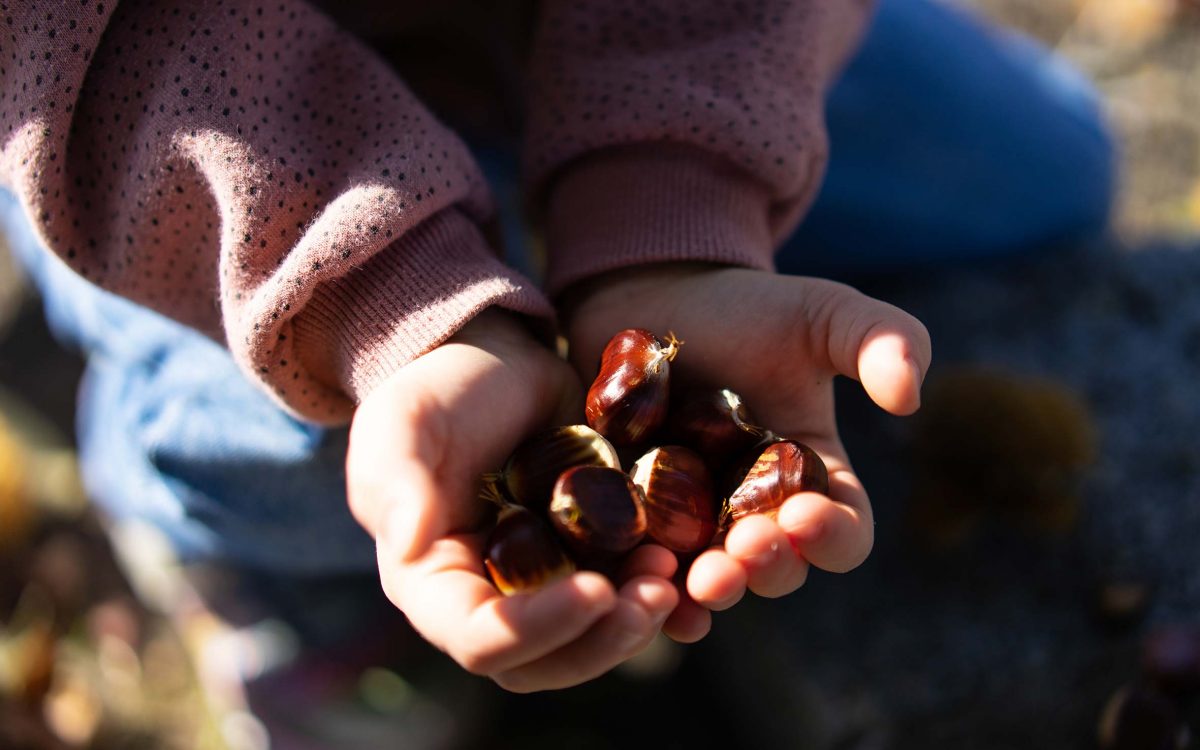When the trees start to turn golden and red, the scent of roasting chestnuts starts filling town squares all over Greece. It’s one of the most anticipated treats of fall and winter, a taste of nostalgia. On the southeastern slopes of Mount Paiko, it’s much more. Chestnuts is the cornerstone of their agricultural, and cultural, heritage. Around the villages of Griva, Karpi and Kastaneri, there’s a chestnut forest of 10,000 “strema” (a strema is 1000 m2) – close to 2,500 acres, about 40% wild, and the rest cultivated. The tree to person ratio is high; Griva, the largest village, has perhaps 500-600 residents, while Kastaneri has just 80 in the winter. In this sparsely populated region, there are over 150 chestnut growers.
“So at any local kafeneio (traditional café), you’d definitely find a chestnut grower or two?” I ask Fotini Vairli, president of the of Chestnut Producers’ Agricultural Cooperative. “Rather, you may meet one or two who’re not – they’re the exception” she replies, “apart from the commercial growers, many families have a few chestnut trees for their own use, and for supplemental income. Even beyond that though, people grow them for sentimental reasons. Chestnuts are part of our heritage here, our agricultural identity. They’re what our grandparents survived on in wartime, making flour out of them, cooking them, eating them raw. They’re still our favorite taste of autumn and winter.”
The chestnut producers’ association aims to preserve that heritage. In addition to supporting growers to maintain quality and determine pricing, the association has a larger goal: to make chestnut production a viable occupation for young people so that they can stay here instead of having to leave in search of work elsewhere.
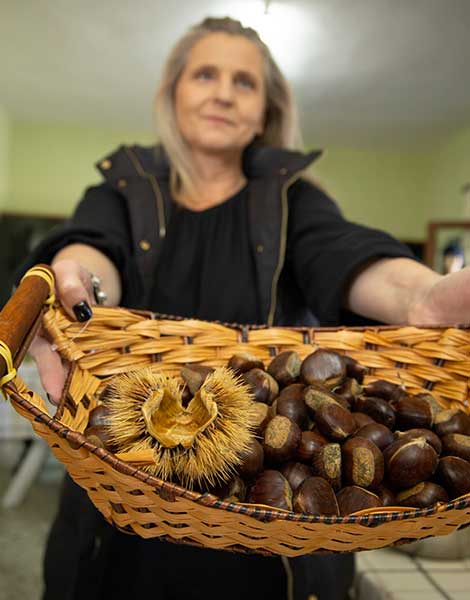
© George Skandalaris
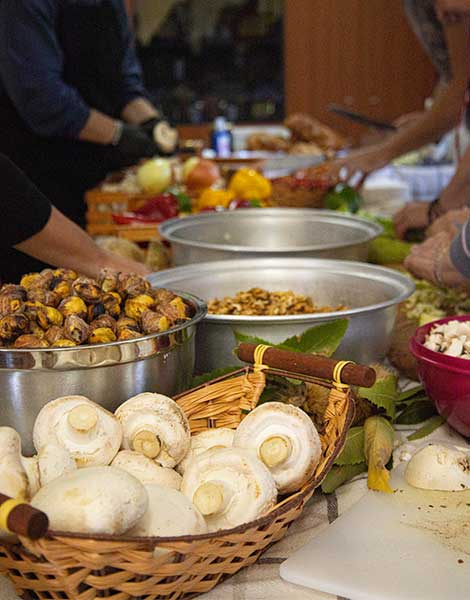
© George Skandalaris
The harvest begins in late September and lasts until around the feast day of Aghiou Dimitriou (October 26th). At its close, the chestnut is celebrated in style, at the Chestnut, Wine, and Cheese Festival of Griva, now in its 24th year. The festival’s reputation has spread; this year’s drew 6,000 visitors. Tour buses and cars from around the region, and also much further away, park along the surrounding narrow roads and people walk into the town, greeted by columns of delicious smelling smoke rising up into the trees. Piles of chestnuts are roasting on grates over large metal fire pits – slightly more than a ton over the two days.
It’s not just the famously good local products drawing the crowds, but the promise of musical entertainment: there’s laika (Greek popular music) as well as the region’s popular chalkina (traditional music that features clarinet and brass) and the lively dancing it accompanies. There’s a stage set up in the main square and tables crowded beside it. Smoky, tender souvlakia, agreeably tinged plenty of char, are eaten out of hand, while a full bodied local wine – a blend featuring the Negoska, a grape that is, together with Xinomavro, an essential representative of the Protected Designation of Origin (PDO) Goumenissa reds – flows from carafes into plastic cups. There’s lots of table hopping; if you’re a stranger when you arrive, you certainly won’t be for long. The people of the region are notably warm and welcoming.
A highlight of the festival’s first day was a cooking class. The members of the Women’s Association of Griva welcomed chef George Palisidis to introduce the versatility of the chestnut. The chef notes that in Greece we mainly associate the chestnut with the kastanás (kastano: chestnut) – the chestnut roasters who appear in town squares all over the cities and towns of Greece as soon as the weather turns cooler, selling the sweet charred treats in little paper cones. There’s also the delicious kastana stifado (chestnut stew) where the nuts stand in for hare or beef, and they show up in Christmas turkey stuffing, but for the most part the chestnut is almost exclusively a street snack in Greece, part of the same tradition as koulouria (sesame covered bread rings) and sahlep (a hot milk drink with sahlep powder).
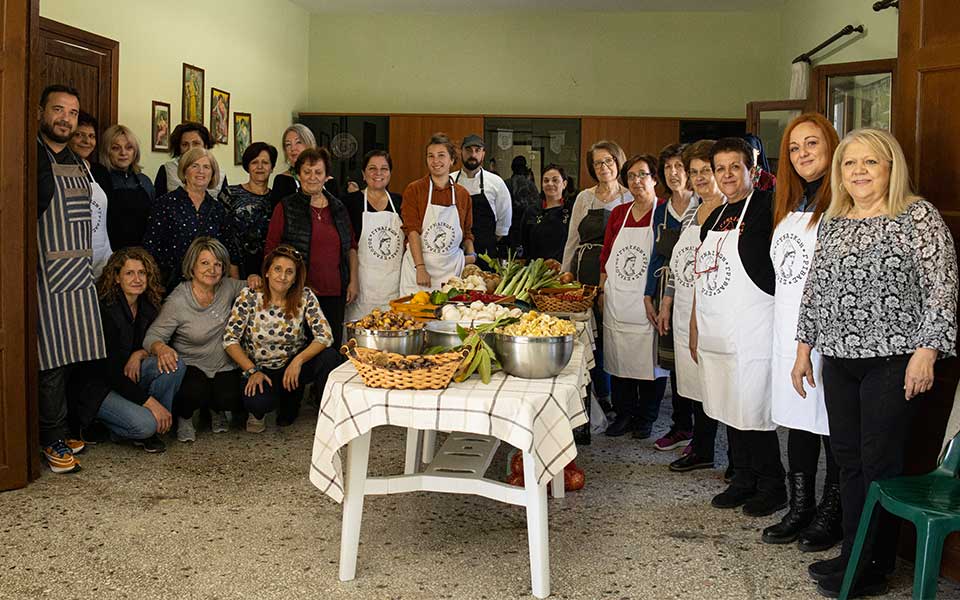
© George Skandalaris
Palisidis, devoted to local, seasonal cuisine, is deeply connected to the Goumenissa region and its fine products. He began to prize chestnuts as an ingredient while he was working in France. “Just like in Greece, the French truly embrace seasonality in their cuisine. In France, the chestnut belongs to the tradition of seasonal cooking, starring in both savory and sweet dishes. Some dishes that I made often in France are also absolutely harmonious with the Greek palate and with our regional products; they celebrate the chestnut and its versatility.”
As an ingredient, chestnuts have a lot going for them, low in fat, high in vitamin C and antioxidants, and – for something delivering such starchy satisfaction – surprisingly low on the glycemic index. Their true appeal though is surely their texture – “velvet” Palisidis says – and their rich flavor, a gentle sweetness that’s as delicious in a soup or risotto as it is in a classic Mont Blanc or a sweet chestnut tsoureki. Palisidis came to Griva to share new ways to enjoy this prized local product, making three recipes with the group. After prepping mounds of fresh local produce, everyone moved outdoors to cook a couple of French-inspired recipes in heritage Greek cookware – huge “kazania,” pots of hammered copper – over flames. The autumn sun was ablaze, foliage of the surrounding slopes tinged with orange and gold, as the scent started to drift through the town. Teenagers from the village showed up to watch, waiting for a taste. A risotto, featuring rice from the Axios Delta nearby, was studded with fat chestnuts and enriched with PDO Kasseri cheese. Chestnuts also starred in a refined, velvety soup made from just a few simple ingredients. Palisidis’ cooking style felt so approachable and intuitive – the recipes conveyed basic techniques for embracing the ingredients of the moment.
Everyone had a little lunch, and a little wine. Then we moved on to a chestnut tsoureki pudding – like a trifle inspired by the mountainous region and its products. Standing in for sponge cake was tsoureki – Greece’s eggy, rich, sweet bread. The cream was made of local sheep’s milk for a richer flavor and sweetened with local honey rather than sugar. Generous spoonfuls of chestnut paste and a hint of rose water flavored it. On top were handfuls of sweet fresh walnuts – another superb regional crop.
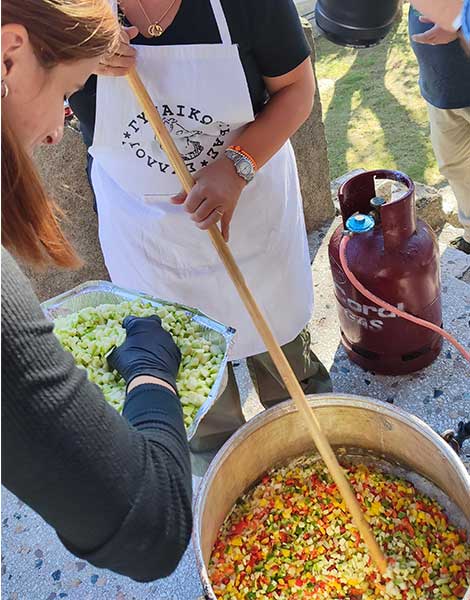
© Amber Charmei

© George Skandalaris
Palasidis and his team, Kiki Gouta and Zacharias Papageorgiou, then went back to work, making more of the same dishes to share at the festival. Portions of chestnut risotto and chestnut soup preceded the souvlakia. Everyone loved them.
While these dishes will surely be turning up on tables in Mount Paiko’s chestnut country this winter, locals will still be enjoying plenty of plain chestnuts, as they always have. Much like martini connoisseurs debate the merits of shaking or stirring, how best to enjoy chestnuts is also a matter of opinion. Roasted, with that delicious smell, to say nothing of that romantic reference in the Nat King Cole song, seems like the clear choice. Although, the boiled chestnut packs just a little more sweetness, and the slight plumping enhances its velvety texture. I ask Fotini Vairli her preference. ”Roasted,” she says without hesitation (of course, that scent) “but our local chestnut species, helped by the ideal microclimate, is so sweet and tender that I also like them raw.”
She shares her tips for preparation: for roasting, you need to score the shells before putting them over the hot coals until they split open, brown, and soften a bit. For boiling, scoring them first and soaking for about a half an hour before boiling makes it easier to remove their inner skins when they’re done. The time needed for roasting or boiling depends on the size – anywhere from 20 minutes for small chestnuts to as much as 50 or more for very large ones. Whether roasted or boiled, they’re an excellent companion to red wine. And she also shares a secret: the smaller ones are often the sweetest.
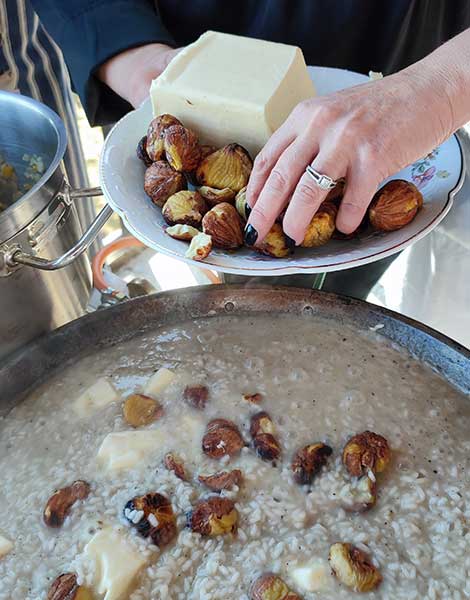
© Amber Charmei

© George Skandalaris
Recipes:
Chestnut Risotto, Paiko Style
Chef: George Palisidis
Sauté vegetables for 20 minutes slowly in olive oil.
Add rice and stir to coat the grains with oil.
In four additions, add the liquids, alternating broth with white wine, and waiting for each to be absorbed before the next addition.
Add salt and pepper to taste, then the butter, cherry tomatoes, grated cheese, and chestnuts before serving.
Ingredients
for the risotto:
350 g rice carolina from the Halastra area
200 g onion
300 ml white xinomavro wine
700 vegetable broth or water
100 g red peppers
70 g green peppers
120 g mushrooms
salt and pepper
100 ml olive oil
to serve:
120 g PDO Kaseri cheese, grated
100 g butter
10 cherry tomatoes
150 g chesnuts, grilled and peeled
Chestnut Soup Velouté
Chef: George Palisidis
Wash the leeks, checking for dirt beneath the outer layers, and cut them in half. Wash the onions and the potatoes, and cook them all in the oven at 190 degrees for 90 minutes.
Peel off the tough outer layer of the roasted vegetables, and place them in a pot with the mushrooms and peeled chestnuts.
Add 1200 mililiters of water and 1 teaspoon of salt, and bring to a gentle boil. After 30 minutes, puree the soup with a stick blender as you add the butter in pieces. Add pepper to taste and adjust for salt.
Serve garnished with walnuts and pieces of chestnut.
(Usually, Palasidis roasts the vegetables as above, concentrating their flavors for a richer soup. However, at Griva, the vegetables were cleaned, peeled, diced and sauteed until they began to gently soften, then we proceeded as above. It was also delicious.)
Ingredients
200 g leeks, cut lengthwise in two
150 g white onions, and whole
400 g potatoes
300 g white mushrooms
200 g chestnuts, boiled and peeled
120 g butter or vegan substitute
salt, pepper
70 g shelled walnuts, chopped
some extra chestnuts for garnish

